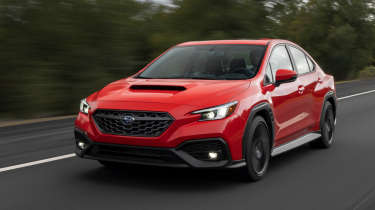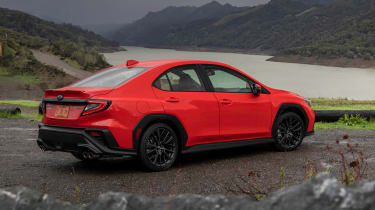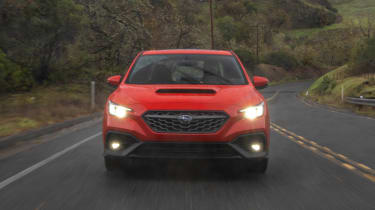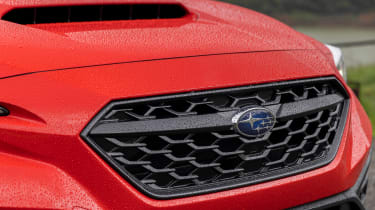New 2023 Subaru WRX review: the Impreza's spiritual successor
The car formerly known as Impreza still lives on in some markets outside the UK. Can the latest Subaru WRX rekindle the excitement of its forefathers? We fly to Los Angeles to find out
Try to forget McRae in full flight. The horns, whistles and hollers as people realise what’s about to come over the hill. Forget that distinctive flat-four noise, the great cracks of anti-lag and the little blue car coming into view at 90 degrees to the direction of travel and then disappearing again in a vortex of mud, gravel and balletic mechanical violence. Forget the ever-more-extreme road cars wearing wafer-thin body panels and cling film-like glass, fitted with literally ‘the cheap seats’ because they were lighter and likely to be thrown away when the car was competition-prepped anyway. Forget the Spec Cs and Type RA‑Rs with trick centre differentials and twin-scroll turbochargers and the sort of focus to make a GT3 or CSL blush. We’ll come back to these cars later.
For now, let’s look at the facts and the mood circling around these parts. We want lighter, simpler cars. We want manual gearboxes, an end to the ever-spiralling power outputs that necessitate bigger tyres, bigger brakes, stronger components and more sophisticated control systems and lead inevitably to increased cost, greater dimensions and mass that only ever seems to go one way. The cruel truth might just be that what we want – and can’t have – is the latest Subaru WRX. The car caught in a time loop, but one that seems to circle around a period when cars were fast, capable and sophisticated but not bloated or weighed down by extraneous technology. Welcome to 2003. Again. Subaru will be your hosts. Annoyingly, you need to fly to the US, Australia or Japan to enjoy the tour.
The WRX is waiting for me in a multi-storey car park near LAX and on the face of it I shouldn’t really be excited at all. Everything about this car’s stats is underwhelming by 2023 standards, maybe even 2010 standards. However, a conventional ICE car with a characterful 2.4-litre turbocharged flat-four producing 271bhp, and 258lb ft from 2000rpm, fitted with a six-speed manual gearbox and a rally-proven four-wheel-drive system for $30,605 (£24,600) doesn’t sound too shabby. You might even call it refreshing. I can’t wait to try it.
Keep forgetting. Even as you approach the WRX. Forget the utilitarian elegance of the classic Subarus or even the wilful ugliness but sawn-off-shotgun sense of purpose of the later JDM specials from the early to mid 2000s. Because from a purely aesthetic point of view the latest WRX is a crushing disappointment. Gawky like a self-conscious teen and trying to hide its awkwardness behind angular stuck-on plastic wheelarches that channel Gandini but look so cheap and naff. Compared with, say, the tension that agitates the GR Yaris even at a standstill, the WRX is anonymous and just a little bit sad. The interior isn’t much better, but I can live with that due to a deep affection for slightly crummy Subaru interiors. Somehow, they used to make the driving experience even more special. Let’s hope that’s still the case.
Some things are new. The WRX is now built upon the Subaru Global Platform and features the FA24F engine – essentially a turbocharged version of the BRZ/GR86 direct-injection flat-four. It has huge boots to fill, as the old EJ series of engines captivated enthusiasts for decades. Oh wow, those old EJ207s fitted to the Spec Cs and revving to 8000rpm were really special. Not that I’m remembering those old cars right now. But if I was I might think that the new engine’s lowly 6100rpm rev limit was a bit of a let-down. Even so, I remain positive. Just the presence of a manual gearbox is enough to keep the spark alive.
It seems odd to focus on the humble manual gearbox quite so much, but it’s worth noting how things have changed. The gradual creep of automatic and dual-clutch ’boxes into performance cars is almost complete, but the few remaining manual proponents perhaps hide the extent of the seismic, ahem, shift. Back in 2003, when a Litchfield-fettled JDM Impreza STI Spec C appeared at eCoty, it was one of 11 contenders in the ‘Real World’ test. The criteria was simple: Fantastic driver’s cars with a sub-£30,000 cost of entry. Admittedly, we included the £38,500 TVR T350C, but the rest were either much less or just hovered around that price point. The Spec C was £27,995.
Of those 11 cars, from a Caterham to hot hatches to coupes to rally reps, precisely none had a self-shifting gearbox. I’m not stupid enough to fall into the manual good/automatic bad trope here, but there’s no question that the landscape skewing so far from the peak Subaru years to now has removed a tactile element of driving enjoyment. And provides an opportunity for the WRX, along with cars like the GR Yaris, GR86, BMW M2 and the Porsche GT models, to really exploit.
So has it? Early signs are not hugely promising. I’m not as attached to the much-loved flat-four warble as many. Most of my Impreza memories are from those JDM homologation cars with twin-scroll turbos and equal-length headers, which lost the distinctive sound. But I’d just kill for any character at the moment. The WRX is quiet, the clutch pedal is so light and imprecise and the deep sense of these sorts of cars being a machine – all that gritty, mechanical connection – appears to have evaporated. The car feels rooted in the past but sanitised for modern tastes.
Nothing quite makes sense. The gearbox is really rather lovely. Much faster and sweeter than previously but with the same length to the throw and a similar texture to each shift. A genuine update with tangible benefits. Sadly, the light, springy clutch undermines every interaction. The ride is stiff and unsettled yet the car doesn’t seem to dig deep into the surface, hunting for grip, and the smooth, low-effort steering can’t convey much about the road that’s rattling the car’s composure. There’s just an odd sense of disconnect. Little glimmers that the WRX still gets it, yes, but it’s almost like the development team didn’t have the confidence to really chase the prize lurking somewhere in this package.
Day one with the WRX is a bit of a disaster. I hate it. Day two isn’t much better. But the little glimmers become more frequent in days three and four. The brake pedal has lovely feel. The ride is busy but the quick steering does help create real agility and the WRX feels light, honest and natural. I wish the engine had more range at the top end and a bit more big-turbo bite, too. But the performance is just about strong enough to challenge the chassis. The torque-vectoring by braking on the front axle even seems to help resist understeer convincingly.
Dynamically the WRX sticks to the path of more recent Imprezas and WRX models rather than drawing inspiration from its wilder ancestors. It’s a little sharper at the front but the rear never really wants to play. Drive hard into a corner on the brakes and the WRX remains resolute. Pour on as much power as the flat-four can summon, even before the apex, and it remains hooked-up and neutral. The fun comes from being precise and carrying speed rather than true throttle adjustability. There’s reward in that style… but true thrills? I’m not so sure. The WRX is one of those cars where you’re always trying to scratch down beneath the surface to find raw excitement. Ultimately, it’s a futile exercise.
Judged purely standing on its own four wheels the WRX does have appeal. It’s affordable, robust and there’s intrigue in the flat-four configuration and incredibly effective four-wheel-drive system. It flies across the ground, too. However, there’s only so long that you can forget the old glories. Even removing the evocative WRC history, those early Impreza Turbos and then STIs and all the iterations they spawned weren’t just affordable and characterful, they changed everything. They were unstoppable, unbeatable cross country; they were sharp and angry but brilliantly accessible. They made us feel like heroes and amplified our talents but always required input and commitment. They were forces of nature. Intense, unique, unforgettable.
They were also a moment in time. How do you recreate that impact when hot hatches can rattle off 0-60mph in sub-four seconds over and over again? How do you go supercar chasing when supercars have 800bhp or more and control systems so sophisticated that they can use every last one? How do you connect motorsport so completely with an affordable road car when motorsport has become more complex to showcase new and expensive technologies that by their very nature increase the cost, complexity and weight of a parallel road car project? Where does the WRX go from here?
The answer, sadly, is probably nowhere at all. Or we’ll get a press release saying the WRX has been reinvented as an EV with 800bhp. Yawn. Luckily, we still have the memories. Remember. Cherish those old images and sounds and moments of fury. Remember McRae, Burns, Spec Cs and Type RA‑Rs. We’ll never see their like again.
The WRX is no substitute, but there’s just enough here to suggest that if Subaru gave itself permission to unleash the potential within, the world would be a much better place. One more STI? A really, properly mad one with no underseal and crappy seats and tin-foil panels and roof scoops? Now that’s a car I’d fly to the ends of the earth to drive.





